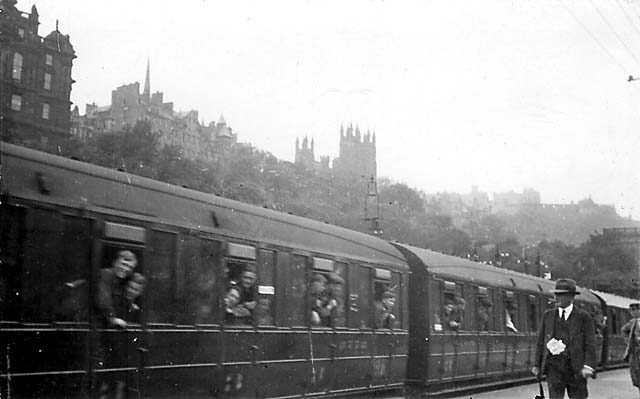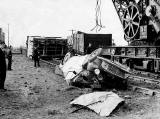|
Railways Waverley Station? What was the occasion? |
Postcard of a train at Waverley Station
When was this photo taken?
© Reproduced with acknowledgement to the sender who wishes to remain anonymous.
Detail from the back of the Postcard
Do you recognise the motif in the stamp box? - Perhaps this might help to date the photograph.
© Reproduced with acknowledgement to the sender who wishes to remain anonymous.
|
Questions August 2006 |
|
The sender of this photograph asks: |
|
When was this photograph taken? "Can you help with dating the photograph and/or identifying the motif in the stamp box? The photograph was among a bundle of postcards bought by a friend of mine. At first I thought it was of WW2 evacuees. However, on closer inspection I've gone off that. But it does look like an organised excursion with an official on the platform. Question asked August 2, 2006 |
|
Please e-mail me if you can help to answer this question. Thank you. - Peter Stubbs |
Comments
From August 2006
Thank to all for the comments below:
1.
|
John Hadden Edinburgh |
|
Thank you to John Hadden, Edinburgh, who sent me the following comments on seeing this photo before it was added to the web site: |
|
"OK, here are some thoughts, though pretty speculative." Before mid-1950s "The carriages are third class so that would make the picture before the mid-fifties. They look like they may be all one dark colour, eg maroon, so could belong to LMS. I understand that LMS operated from Caledonian Station while LNER operated from Waverley, so the train may have left from Caledonian. There is a blurring of the faces in the image which could suggest that the train was moving, which would be the case if the train was passing through Waverley rather than leaving from there." But see comments from Patrick Hutton below. - Peter Stubbs Unplanned photo? "The subject of the photograph appears to be the train and the nearest faces seem to be looking directly at the camera. However, the photographer may have been trying to capture more than just those few people, and include some of the Caste hill skyline. If the photographer had wanted a picture of the train, wouldn't they be more likely to have taken it when the train was sitting still?
It is subjective but I think that the
composition of the image does not seem as good as it might have
been given time to plan it. So, I suspect that this could have
been an unplanned situation where the photographer realised that
there was some significance in this particular train and Glencorse Recruits? "Building speculation on speculation isn't a good idea but I was wondering, if the train had left from Caledonian Station, would the occupants still be hanging out the windows through Waverley? Probably only if they felt that they had an audience there? The visible faces are all young men, so perhaps new recruits on their way to Glencorse?" On the Platform "We see two men on the platform. The nearer one could be a railway official (at first I thought he was holding a flag), but he also appears to be holding a pair of gloves and smoking a cigar, so perhaps not. The other guy is wearing plus-fours. I have no 1st hand experience of the fashions of that time, but I suspect that plus-fours were not very fashionable even then. Unless you were a retired army general or something like that." Notices on the Carriages "There are some white marks that may be chalked writing between the last two compartments on the first carriage. There also may be destination or "reserved" notices in a couple on the windows." Summer "There are leaves on the trees, so should be summer-time. If there were other photos available of the same area then perhaps the heights of trees could indicate the approximate era of the photograph." Back of the Postcard "There's not a lot to say about the logo on the back, unless someone actually recognises it. It looks art deco in style so possibly originated in the 1920s or 30s? Also, as there is no indication of a stamp instruction, the postcard stock manufacturer has placed their logo on it. The logo looks like a stylised wing to me. I don't recognise any letters that may have been incorporated in the design." Front of the Postcard "The image on the front isn't titled and doesn't look like it would have a lot of sales potential, so I suspect that some sensitised postcard stock was used to print the image. If the numbers on the carriages are decipherable on the original, then perhaps a railway buff could date them quite accurately (It was interesting to see how much Post Office van data was produced, in the right hands). PO Van Accident John Hadden, Edinburgh: August 7, 2006 |
|
The sender of the original photograph replied |
|
Under the Magnifying Glass "I hadn't noticed that the man in the foreground was smoking a cigar! I think he is holding a rolled umbrella in his right hand and there is a black blotch on the photo. I've been looking at the original using a higher power, illuminated magnifying glass and the number on the first carriage is 3772. The writing is not legible but the notices say Reserved. My feeling is that the train is leaving from Waverley; the people in the second carriage are looking backwards." Comments received: August 9, 2006 |
2.
|
Patrick Hutton Edinburgh |
|
Thank you to Patrick Hutton, Edinburgh, who wrote: |
|
Stations There was no real connection between the LMS station (Princes Street, behind the Caledonian Hotel) and the LNER station at Waverley. It was only when BR put in the Slateford-Craiglockhart link (to the South Sub) and the Duff Street siding was converted into a link from Gorgie to Haymarket (both of these in the 1960s) that the networks were properly joined. Before then through freight would be worked via Ravelston (LMS) to Granton Harbour, and then back via Powderhall (LNER). The Duke of Buccleuch collected a fee for the transfer, as he owned the land at Granton harbour." Carriages "I'm Pretty certain the carriages are LNER - the numbering looks familiar. The teak was varnished and would look dark." Passengers "I think the occupants are soldiers - aren't the blokes in the closest windows wearing glengarries? It could be almost anything: - regulars off to France in 1939-40? - a Territorial unit off to summer camp in the 1930s? - etc. John Hadden, Edinburgh: August 11, 2006 |
3.
|
Douglas Beath Burnie, Tasmania |
|
Thank you to Douglas Beath, Burnie, Tasmania, for helping to narrow-down the date of this photo. Douglas wrote: |
|
1937 or earlier "The photo is not after October 1937 when Waverley signalling was modernized from mechanical semaphores to electric colour-lights (Source: Hunter, p167)." Platform "From signals and platform light behind train, it's not the southern through track. It's a terminal track that westbound (but not Fife) trains generally used; though a special excursion could involve an untypical platform usage." Carriages "The coaches I feel must be LNER, and the numerous doors indicate compartment coaches, i.e. not long-distance corridor stock." Passengers "The narrow age range of passengers (and all men?) and the window stickers suggest a special or at least a reserved portion." Douglas Beath, Burnie, Tasmania: August 13, 2006 |
4.
|
Andrew Daniel Edinburgh |
|
Thank you to Patrick Hutton for making further enquiries about the carriage, No 3772 in this photograph. Patrick received the following reply from Andrew Daniel of the LNER Coach Association. Andrew wrote to Patrick: |
|
Carriages "You are correct. The coaches in the photograph are LNER suburban stock, designed by Sir Nigel Gresley. I have not got my books to hand so I have not been able to look up when 3772 was built or its type to confirm that this is the vehicle. However because it begins with a 3 indicates the coach belonged to the southern Scottish division of the LNER. This type of coach was mostly built between the late 1920s and no later than 1939. As there is no evidence of blackout in the windows (a black edge to the glass so no light could shine out of the edge of the blinds) and the coaches look quite smart I would say that it was unlikely that it was taken after 1940. The coaches would have looked tired post war and would have been painted after 1949. I would think it was taken between 1935 and 1941, a troop train perhaps?" Andrew Daniel Webmaster LNER Coach Association: August 14, 2006 |
5.
|
Simon Batchelor York, Yorkshire, England |
|
Thank you to Simon Batchelor who wrote: |
|
Carriages "The carriage would appear to be a Non Vestibule, Non Articulated, teak bodied Third, built by the Metropolitan Carriage Works and Finance Company Limited (later a constituent of Metropolitan Cammell) in 1927. The carriage was built for use in the Southern Scottish Area of the LNER. The photograph would date from between 1927 and 1943 as a new numbering system came into effect in the latter year."
Simon Batchelor, Research Centre Assistant,
National Railway Museum, |
|
Alan MacFarland Rensselaer, Indiana, USA |
|
Thank you to Simon Batchelor who wrote: |
|
Carriages "Those are World War 2 soldiers, probably heading to Glencorse. Post WW2, soldiers (National Servicemen) had open neck tunics and ties. We also wore TOSs in transit, not Glengarries Alan McFarland (Ex 1st Bn. KOSB). Rensselaer, Indiana, USA, November 20, 2007 |
|
Alan MacFarland Rensselaer, Indiana, USA |
|
I e-mailed Alan MacFarlane thanking him for 6. above. I also said to him: "You mentioned WW2 soldiers. However, you'll see from answer 3 on this page that somebody else believes the photo to have been taken before WW2. He suggests 1937 or earlier. Do you have any views on what the possible range of dates for the photo?" Peter Stubbs: November 20, 2007 |
|
Alan replied: 1930s "Looking at the photographs again I am inclined to agree that the photograph is circa 1937. The plus-fours on the gent indicate a 30-ish era. My dad wore those hairy tweeds back then. What fun! The Waverley Station nostalgia is beginning to creep in! I can still remember the excitement of going home from Dreghorn barracks for a weekend in Largs during late '49. I wore a cool looking Glengarry then because I didn't want to be seen with that big TOS (Tam o'Shanter) on my head! No offense intended - I don't want to upset anyone's regimental pride." Alan McFarland (Ex 1st Bn. KOSB). Rensselaer, Indiana, USA, November 29, 2007 |
|
Wikipedia has pictures of Tam o'Shanter and Glengarry caps. Peter Stubbs: November 29, 2007 |
|
Answer (so far) |
|
Details above indicate that this photograph would have been taken some time between 1927 and October 1937. - Peter Stubbs |
|
Scottish Railway Lines and Stations |
||||||
| East Lothian | West Lothian | Accidents | Equipment | |||
|
TRANSPORT |
|||||||
| Full Index |
Bus Tickets |
Railway Tickets |
|||||
|
RAILWAYS: Where is it? - No 1 ANSWERED |



